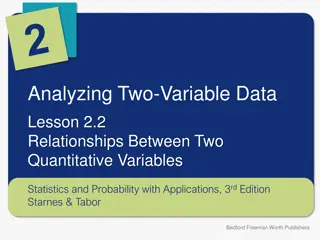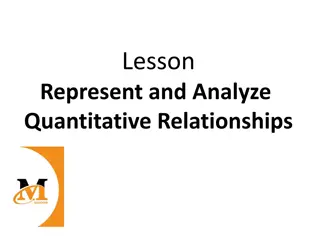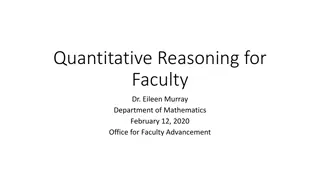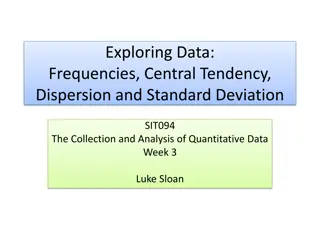
Quantitative Data Analysis Techniques for Researchers
Explore the world of quantitative data analysis with techniques to convert data into numerical forms for statistical analyses. Learn about data preparation, types of variables analysis, univariate analysis, and distribution analysis in this informative presentation by Mr. Chithravel V, Assistant Professor at A.C.N.
Download Presentation

Please find below an Image/Link to download the presentation.
The content on the website is provided AS IS for your information and personal use only. It may not be sold, licensed, or shared on other websites without obtaining consent from the author. If you encounter any issues during the download, it is possible that the publisher has removed the file from their server.
You are allowed to download the files provided on this website for personal or commercial use, subject to the condition that they are used lawfully. All files are the property of their respective owners.
The content on the website is provided AS IS for your information and personal use only. It may not be sold, licensed, or shared on other websites without obtaining consent from the author.
E N D
Presentation Transcript
Quantitative Data Analysis Data Analysis Presenter: Mr.Chithravel.V Asst.Professor A.C.N 1
1.0 INTRODUCTION Quantitative analysis involves the techniques by which researchers convert data to numerical forms and subject them to statistical analyses. Involves techniques Involve task of converting data into knowledge Myths: x Complex analysis and BIG WORDSimpress people x Analysis comes at the end after all the data are collected x Data have their own meaning. 2
2.0 QUANTIFICATION OF DATA The numerical representation and manipulation of observations for the purpose of describing and explaining the phenomena that those observation reflect. (Babbie, 2010, p. 422) 3
2.1 Data Preparation CODING & DATA ENTRY DATA EDITING MISSING DATA TRANSFORM Data must be inspected for completeness and consistency. E.g. a respondent may not answer the question on marriage. But in other questions, respondent answers that he/she had been married for 10 years and has 3 children Elimination of questionnaire (missing >10% of the total response) Involves quantification (process of converting data into numerical form) E.g. Male 1, Female 2 Changing data into new format. E.g. reduce 5 Likert- type Scale into 3 categories 4
2.2 Types of Variables Analysis One variable (Univariate) E.g. Age, gender, income etc. Two variables (Bivariate) E.g. gender & Knowledge on hypertension several variables (Multivariate) E.g. Age, education, and knowledge 1 2 3 UNIVARIATE ANALYSIS BIVARIATE ANALYSIS MULTIVARIATE ANALYSIS 5
3.0 UNIVARIATE ANALYSIS Univariate analysis is the analysis of a single variable. Because Univariate Analysis does not involve relationships between two or more variables, its purpose is more toward descriptive rather than explanatory. 6
3.1 Distribution Frequency distribution is counts of the number of response to a question or to the occurrence of a phenomenon of interest. (Polonsky & Waller, 2011, p. 189) Obtained for all the personal data or classification variables. (Babbie, 2010, p. 428) Gives researcher some general picture about the dispersion, as well as maximum and minimum response. 7
Distribution (cont) 1. What is your specialty preference? 1.MSN __2. PEDIATRICS__3.OBG ___4.PSYCHIATRY__5.COMMUNITY TABLE 3.1: Specialty Preferences Valid Percent 60.0 24.8 1.8 9.9 3.5 100.0 Cumulative Percent 60.0 84.8 86.6 96.5 100.0 Frequency Percent M.S.N PEADIATRICS OBG PSYCHIATRY COMMUNITY Total Missing 9 NA Total 886 367 26 146 52 1477 9 1486 59.6 24.7 1.7 9.8 3.5 99.4 0.6 100.0 8
Distribution (cont) FIGURE 3.2: Specialty Preferences Missing 6% Other 3% None 9% Jewish 2% Catholic 23% Protestant 57% 9
Central Tendency 3.2 Present data in form of an average: 1. Mean = 2. Mode = most frequently occurring attribute 3. Median = Middle attribute in the ranked distribution of observed attribute 10
Central Tendency(cont) Age 20 19 20 20 19 18 19 17 18 18 19 21 23 251 GPA 1.9 1.5 2.1 2.4 2.75 3 2.85 2.75 3.3 3.1 3.4 4 3.9 36.95 2.8423 0.5437 0.7374 2.85 Gender M M M F M M M M F M F F F Hours 1 1 2 3 4 4 5 5 5 6 7 8 8 59 4.5385 5.6026 2.367 5 AGE OF RESPONDENTS 1 2 3 4 5 6 7 8 9 10 Bob 11 Kate 12 Sally 13 Sylvia Sum Mean Variance Std Dev Median Dick Edward Emmett Lauren Mike Benjie Joe Larry Rose Mean = Sum = 251 N 13 Mode = Most frequent value = age 19 (4) 19.308 2.3974 1.5484 19 Median = 19 11
Dispersion 3.3 Distribution of values around some central value, such an average. Example measure of dispersion: Range: The distance separating the highest from the lowest value. Variance To describe the variability of the distribution. Standard deviation: An index of the amount of variability in a set of data. Higher SD means data are more dispersed. Lower SD means that they are more bunched together. 12
Continuous & Discrete Variables 3.4 Continuous Variable A variable can take on any value between two specified values. An infinite number of values. Also known as quantitative variable E.g. Income & age Scale: Interval & Ratio Discrete Variable A variable whose attribute are separate from one another. Also known as qualitative variable E.g. Marital status, gender & nationality. Scale: Nominal & Ordinal 13
4.0 SUBGROUP COMPARISON Bivariate and multivariate analyses aimed primarily at explanation. Before turning into explanation, we should consider the case of subgroup description. TABLE 4.1: Marijuana Legalization by Age of Respondents, 2004 Under 21 27% 73 (34) 21-35 40% 60 (238) 36-54 37% 63 (338) 55 & older 24% 76 (265) Should be legalized Should not be legalized 100%= Source: General Social Survey, 2004, National Opinion Research Center. Subgroup comparisons tell how different groups responded to this question and some pattern in the results. 14
4.1 Collapsing Response Categories Combining the two appropriate range of variation to get better picture or meaningful analyses. TABLE 4.2: Attitudes toward the United Nations. How is the UN doing in solving the problems it has had to face? TABLE 4.3: Collapsing Extreme Categories Source. 5-Nation Survey Finds Hope for U.N., New York Times, June 26, 1985, p.6 15
4.2 Handling Dont Knows Whether to include or exclude the don t knows is harder to decide. TABLE 4.3: Collapsing Extreme Categories TABLE 4.4: Omitting the Don tKnows EXCLUDED Different / Meaningful interpretation can be made. But sometimes the Don t Knows is important. It s appropriate to report your data in both forms so your readers can draw their own conclusion. 16
4.3 Numerical Descriptions in Qualitative Research The discussions are also relevant to qualitative studies. The findings off in-depth, qualitative studies often can be verified by some numerical testing. EXAMPLE: David Silverman wanted to compare the cancer treatments received by patients in private clinics with those in Britain s National Health Service. He primarily chose in-depth analyses of the interactions between doctor & patients. He also constructed a coding form which enabled him to collate a number of crude measures of doctor & patients interactions. < Average = 10 to 20 minutes; Average = 21 to 30 minutes; > average = more than 30 minutes 17
5.0 BIVARIATE ANALYSIS In contrast to univariate analysis, subgroup comparisons involve two variables. Subgroup comparisons constitute a kind of bivariate analysis the analysis of two variables simultaneously. However, as with univariate analysis, the purpose of subgroup comparisons is largely descriptive. Most bivariate analysis in social research adds on another element: determining relationships between the variables themselves. 18
BIVARIATE ANALYSIS TABLE 5.1: Religious Attendance Reported by Men and Women in 2004 Table describes the church attendance of men & women as reported in 1990 General Social Survey. It shows: comparatively & descriptively that women in the study attended church more often as compared to men. However, the existence of explanatory bivariate analysis tells a somewhat different story. It suggests: gender has an effect on the church attendance. 19
BIVARIATE ANALYSIS Theoretical interpretation of Table 1 in this subtopic might be taken from CHARLES GLOCK S COMFORT HYPOTHESIS: 1. Women are still treated as second- class citizens in U.S. society 2. People denied status gratification in the secular society may turn to religion as an alternative source of status. 3. Hence, women should be more religious than men. 20
5.1 Percentaging a Table In reading a table that someone else constructed, one needs to find out which direction it has been percentaged. Figure 5.1 reviews the logic by which we create percentage tables from two variables. Variables gender and attitudes toward equality for men and women is used. 21
Percentaging a Table (cont) Figure 5.1: Percentaging a Table a. Some men and women who either favor (+) gender equality or don t (-) favor it. b. Separate the men from the women (the independent variable). 22
Percentaging a Table (cont) c. Within each gender group, separate those who favor equality from those who don t (the independent variable) d. Count the numbers in each cell of the table. 23
Percentaging a Table (cont) e. What percentage of the women favor equality? f. What percentage of the men favor equality? 24
Percentaging a Table (cont) g. Conclusion RULES TO READ TABLE: TABLE 5.2: Gender and attitudes toward equality for men and women. 1. If the table percentaged DOWN, read ACROSS. 2.If the table percentaged ACROSS, read DOWN. While majority of both men and women favored gender equality, women are more likely than men to do so. Thus, gender appears to be done of the causes of attitudes toward sexual equality. 25
5.2 Constructing and Reading Bivariate Tables Steps involved in constructing of explanatory bivariate tables 1. The cases are divided into groups according to attributes of the independent variable. TABLE 5.2: Gender and attitudes toward equality for men and women. 2.Each of these subgroups is then described in terms of attributes of the independent variable. 3.Finally, the table is read by comparing the independent variable subgroups with one another in terms of a given attribute of the dependent variable. 26
6.0 MULTIVARIATE ANALYSIS The analysis of the simultaneous relationships among several variables. E.g. The effects of Religious Attendance, Gender, and Age would be and example of multivariate analysis. TABLE 6.1: Multivariate Relationship: Religious Attendance, gender, and Age Age Gender Religious Attendance Source: General Social Survey, 1972 2006, National Opinion Research Center. 27
7.0 SOCIOLOGICAL DIAGNOSTICS Sociological diagnostics is a quantitative analysis technique for determining the nature of social problems such as ethnic or gender discrimination. (Babbie, 2010, p. 446) It can be used to replace opinions with facts and to settle debates with data analysis. EXAMPLE: Issues of GENDER and INCOME Because family pattern, women as group have participated less in in the labor force and many only begin outside the home after completing certain child-rearing tasks. 28
8.0 CONCLUSION In quantitative data analysis we classify features, count them, and even construct more complex statistical models in an attempt to explain what is observed. Findings can be generalized to a larger population, and direct comparisons can be made between two corpora, so long as valid sampling and significance techniques have been used. Thus, quantitative analysis allows us to discover which phenomena are likely to be genuine reflections of the behavior of a language or variety, and which are merely chance occurrences. 29
REFERENCES Assessment Committee. (2009). Quantitative Data Analysis. Unpublished PowerPoint Presentation. Emory University. Babbie, E. (2010). The Practice of Social Research (Twelfth ed.). California: Wadsworth Cengage Learning. Gusukuma, I. V. (2012). Basic Data Analysis Guidelines for Research Students. University of Mary Hardin-Baylor. Hair, Jr., J. F., Money, A. H., Samouel, P., & Page, M. (2007). Research Methods for Business. England: John Wiley & Sons Ltd. 30






















